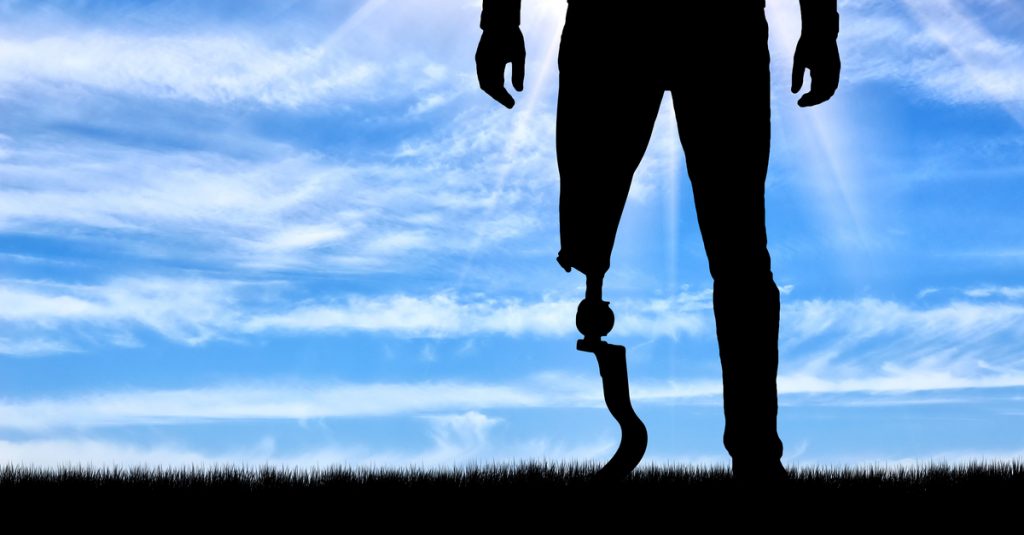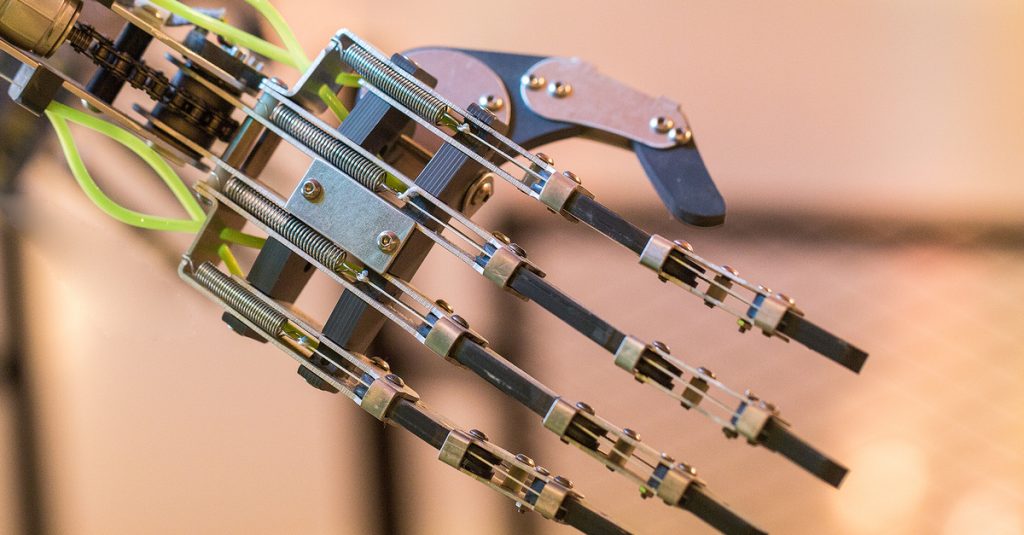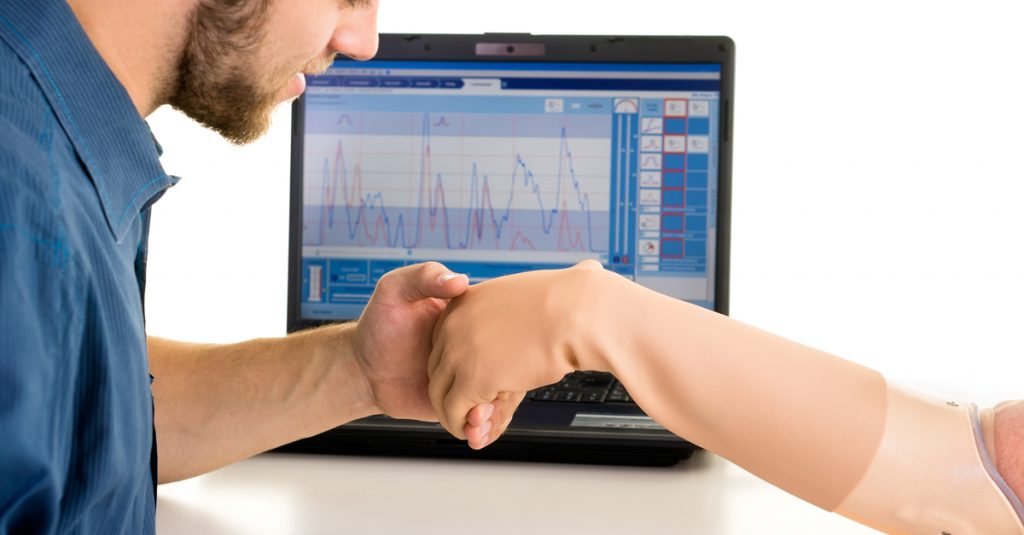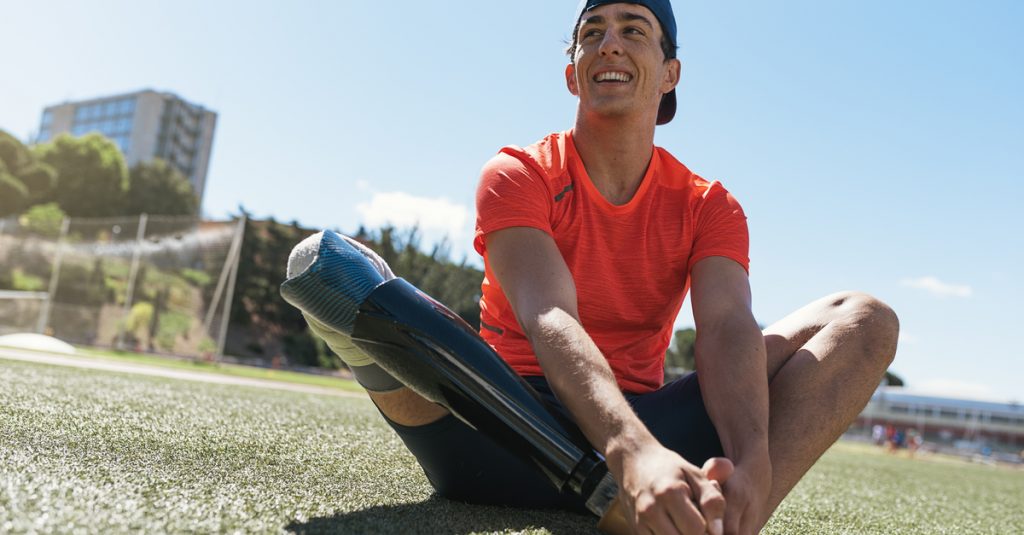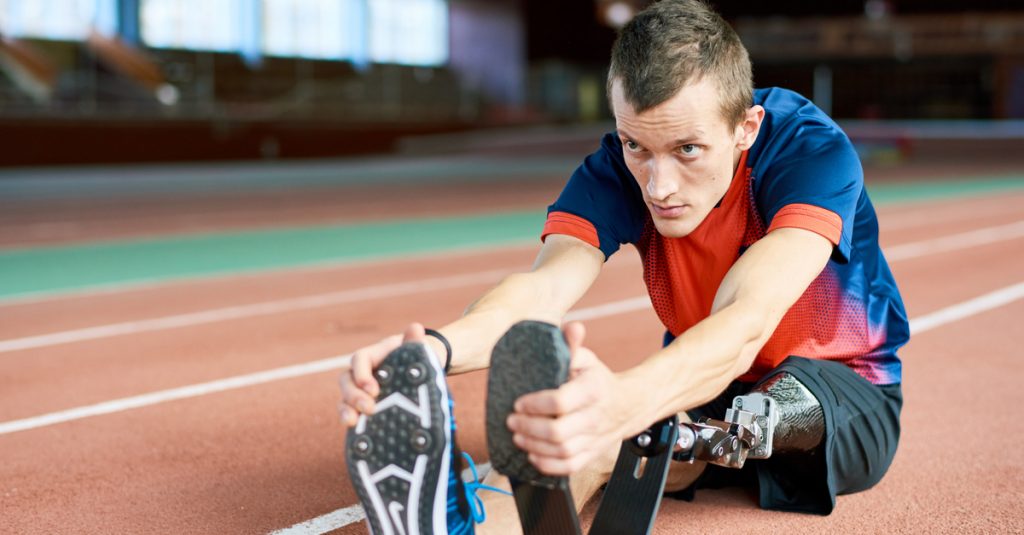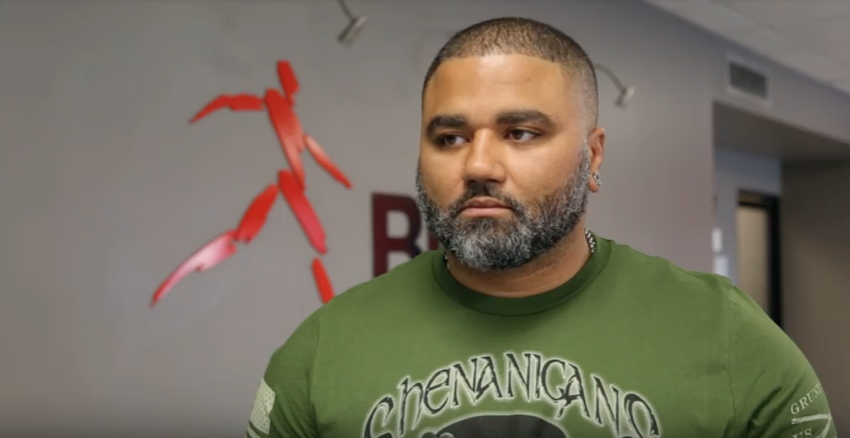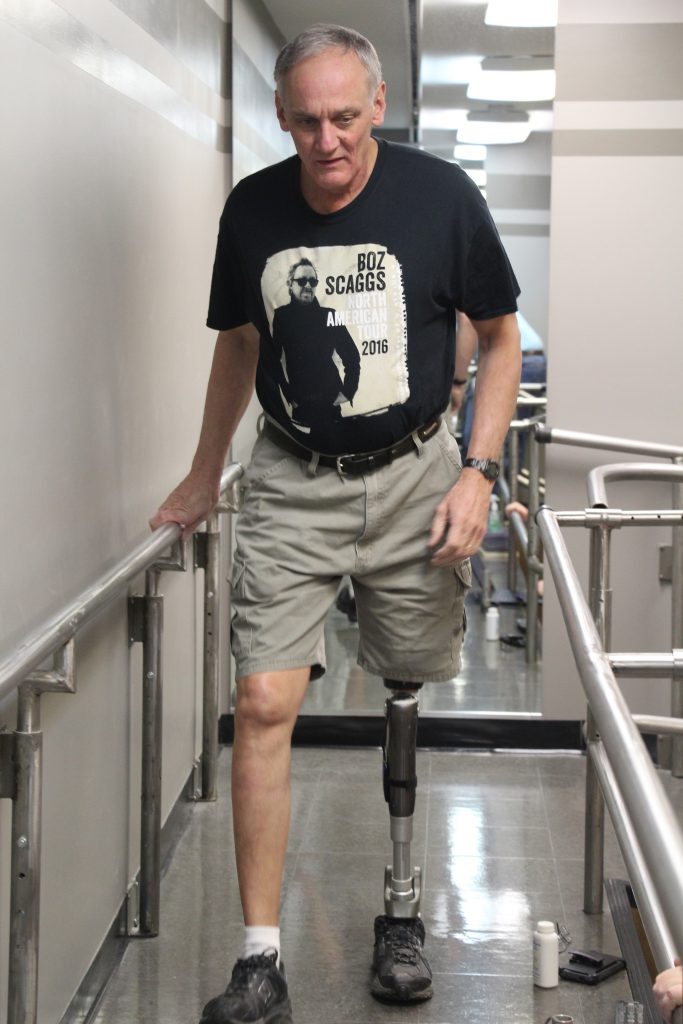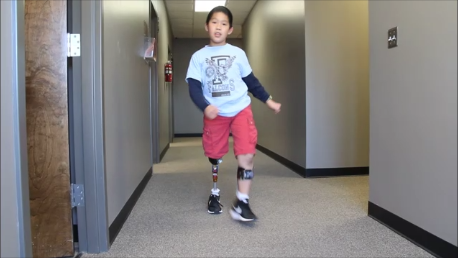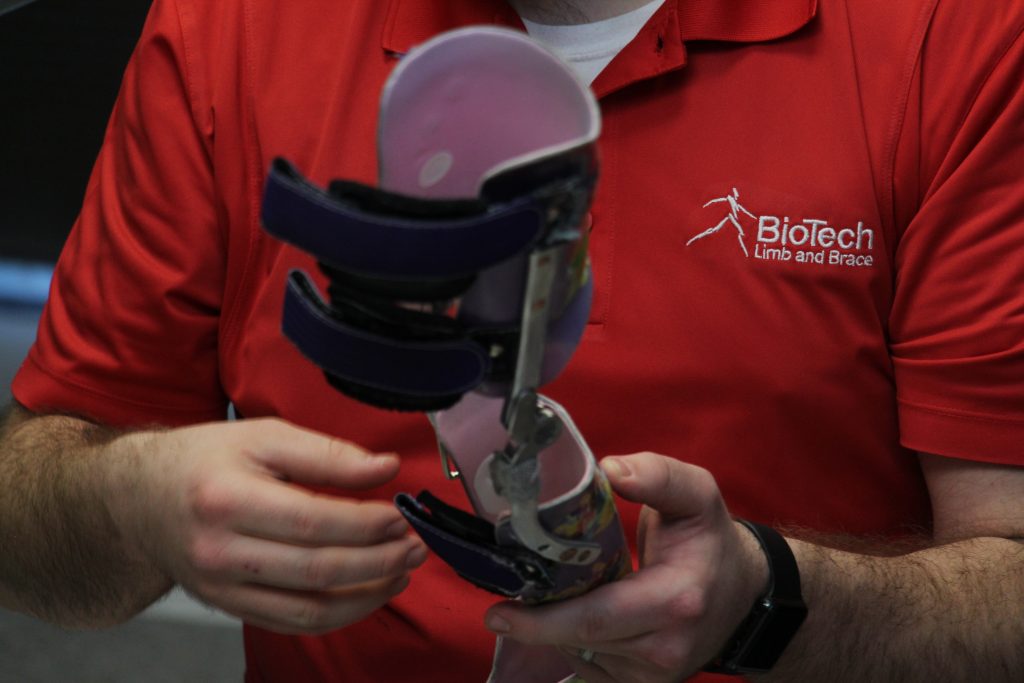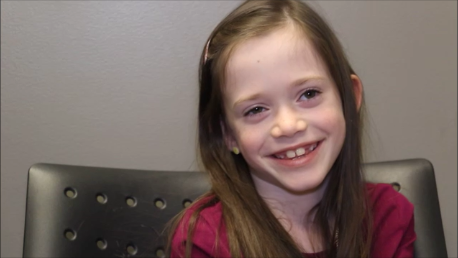Learning to walk is something we think we’ve already accomplished as were toddlers. But for amputees, it’s not something to be taken for granted - it’s something that has be learned all over again.
Walking with a prosthetic device can be difficult and challenging at first, but with practice, advice, and help from professionals, it’s definitely possible. You’ll be surprised at how well you’ll be able to walk once you get used to your new device.
Here are tips for learning to walk again with a prosthesis.
Start Slow and Work Your Way Up
When we rehab patients with new devices, we always start slow.
The first thing to learn how to do is stand on your own two feet. You’ll feel unbalanced and unsteady, but that’s natural. We typically let people sit in chairs and then use their upper body to raise themselves out of the chair and stand using handholds or bars for support.
The next step is to learn how to stand and balance without holding onto something. This may be difficult because your legs might not be in good enough condition, strength-wise, to do it, but with practice, you’ll get there.
Then, we start walking. The journey of a thousand miles begins with one step. Likewise, the journey to walking normally begins with one step, and then another, as we guide you along using bars for support.
At BioTech, we have rooms dedicated for this purpose. We have long walkways and ramps with bars and mirrors to help you not only start walking safely, but also to check out your form and see how you’re doing.
Along the way, we give you a constant stream of advice - move that foot up a little more, take a bigger stride, etc., things to help you progress in walking.
Advice for When You Start Walking
So you’ve learned to walk with your prosthetist helping you - what next?
When you’re out and about, there are things you need to stay aware of so you can walk safely.
For starters, be mindful of the terrain. Even a small rock can cause you to stumble. Make sure you avoid debris in front of you. Again, it doesn’t take much to trip you up.
Also, take special care when you’re walking up a slope or down a slope. You’ll have to go slower at first, especially when going down a slope. Gravity isn’t your friend. Take longer strides going down so you have a better base for your body and work to drive your leading foot into the ground so it gets a nice, firm grip - and resist the urge to lean forward.
You can practice on different surfaces, too, like asphalt, tile, carpet, wood, etc. Additionally, you can practice how to get back on your feet if you fall, and how to carry things while walking and keeping your balance.
With regular practice and a lot of determination, you can overcome the challenge of walking again and develop a normal, confident stride like our patients. Others have gone before you and done it - and you can do it, too!
BioTech helps amputees walk again by designing well-fitting and effective prosthetic devices and guiding patients in learning to use them - and recognize their possibilities. Contact us to learn more.
Technology is a wonderful, almost miraculous thing. It can enhance our lives and help us get back to normal after the trauma of an amputation. The best thing is that it’s constantly advancing and getting more beneficial every year.
At BioTech, we place a high premium on technology because we know that using technology only benefits our patients. We keep our fingers on the pulse of prosthetic device tech and share what we find with our patients so they’re informed about what we can do for them.
Here’s what’s changing the game for prosthetic devices today.
CAD-CAM Software and Devices Are Revolutionizing Fittings
When you get a prosthetic device, you need to be fitted for it. The traditional way of casting and measuring still works and can work well - but you’ll get a better fit for your prosthesis if you incorporate technology.
Computer-aided drafting (CAD) and computer-aided manufacturing (CAM) systems, called CAD-CAM for short, takes computer technology to the next level for prosthetic device design and creation.
In our office, we can scan your limb using a CAD-CAM scanner, upload it into our computer, and use powerful software to make modifications as necessary. Then, we feed that 3D model into a specially designed automated robot carving machine that carves an exact physical device using the design the software created - all from a real scan of your actual limb!
It’s amazing how precise, accurate, and comfortable your prosthesis can be using this technology, and we’re proud to use it on a daily basis.
Microprocessors Are Turning Prosthetic Devices Into “Smart” Devices
Prosthetic device manufacturer Otto Bock changed the game forever when they released their revolutionary C-Leg, which is controlled by tiny computers called microprocessors. This advance basically turned a regular, non-technological device into a “smart” device that helps better replicate a natural human limb’s motion using the power of computers.
A C-Leg adjusts the mechanics of the leg - particularly the swing - in real time as you walk. This enables a smoother, more natural gait that is also more stable and less tiresome. The microprocessors are working at the speed of light to modify how the leg moves so you’re getting a better experience with each step.
Now, the market is filling up with other microprocessor-controlled limbs, including some that are even trying to replicate the sensation of touch.
It’s an exciting time to be alive if you’re an amputee. What is possible now wasn’t possible 5 or 10 years ago, and what will be possible 5 or 10 years from now will astound us.
Contact the team at BioTech to learn more about how advanced technology in our office can help you find the prosthetic device to return normalcy to your life and give you a chance to recognize your possibilities.
The technology behind prosthetic limbs is constantly changing and evolving. One “holy grail” of prosthetic limb technology is to accurately and reliably simulate touch and feel of a natural limb in an artificial one.
Soon, according to researchers, that may be a very real possibility.
Researchers at the University of Illinois announced this month that they have designed an algorithm to give special prosthetic limbs the sensation of touch to their wearers.
These limbs are outfitted with electronics and sensors that, with the algorithm, can give amputees realistic sensations when they touch objects - something that has been elusive until very recently.
Of course, there are already advanced electronic prosthetic limbs that can provide some sensation of touch. However, these are relatively rudimentary and lack sophisticated algorithmic control to provide a consistent, ongoing, and accurate response.
The technology from the University of Illinois lab, though, can moderate signals from touching and handling objects and surfaces so that the sensation is prolonged and consistent.
The goal of the researchers is to give amputees limbs that feel like extensions of their bodies. That’s the goal of the prosthetic industry in general, but so far, accurate representations of touch have proven elusive. Plus, cost is an issue; advanced bionic limbs with that capability are prohibitively expensive for many.
The hope of the research team is to scale down the control module that handles the software and sensors so that it can fit within a normal-sized prosthetic limb and be affordable enough to be mostly or totally covered by insurance.
Reliable and consistent feedback is something that every amputee would love to have in their prosthetic limbs. With this new breakthrough, we’re one step closer to having that capability across all prosthetic limbs at some point in the future.
At BioTech, we’re all about using technology to improve the experience of our patients. That’s why we employ advanced methods to ensure a better fit and better performance for our patients who wear our limbs.
Contact us for a consultation and let us share how we can help you get the most of your prosthetic device so you can go above and beyond - and recognize your possibilities.
There are options for prosthetic and orthotic devices - from AFOs to artificial legs - for those who have suffered from limb loss and other debilitating conditions.
But, it’s important to understand that not all options are equal. There is actually quite a bit of difference between one provider and another - and those differences can lead to a good or bad experience, depending on who you choose.
At BioTech, there are several things that set us apart from the rest of the field - advantages that we have compiled in our decades of operation. We’re proud of what we can offer that other providers can’t because we believe strongly in giving you choices, including choices that work best for you and your family.
In-House Fabrication
Most prosthetic/orthotic providers are 1-2 men operating in a small office. They can take your measurements, but they send them off to a fabrication facility, which means they - and you - have to wait for them to get sent back from the facility. And if it doesn’t fit, they have to send it back to the fabricators and you have to wait again for your device.
BioTech is different. We have a full team, including in-house fabricators who can make just about anything you need. This is good for two reasons:
- In-house fabrication saves time. You get your device faster, even if adjustments have to be made.
- We control the quality of your product. You’re not at the mercy of third-party fabricators whom you’ve never met.
By fabricating in our own facility, we can also catch issues before they arise and amend them on site. It’s not uncommon to see us leave a patient, take the device in the back, adjust it, then bring it back to the room and test the fit on the patient, all in a span of minutes. With other providers, that would take days, even weeks.
A Better Facility
We’re very proud of our facility, which we think is second to none.
For starters, our facility is clean, well-lit, spacious, and comfortable. We made it this way on purpose because we know that’s what our patients expect. We were also disappointed with other facilities we’ve been in, and didn’t want the same subpar experience for our patients
Additionally, our facility uses state-of-the-art technology, from 3D computer scanners to fabrication equipment and an awesome, high-tech carving robot. And, we have the experience to operate all of this technology in a way that makes your device look and fit better than what you can get anywhere else.
Visit Us to Learn More
If you need prosthetic or orthotic care, the provider you choose matters, and we want you to get the best experience. The best way to get a full glimpse of what BioTech can offer is to contact us and pay us a visit.
Our goal is a five-star experience for you, every time, and when you come to see us for your prosthetic or orthotic care, that’s exactly what you’ll get.
One thing amputees want to do once they heal up and recover is to get back in shape - or get in shape for the first time! But they think, “Well, I can’t do this,” or, “I’ll never get back in the gym,” or, “There are certain things I just won’t be able to do.”
Of course, none of that is true! You can do it - you just have to do what everyone has to do when they want to get in shape: figure out the best way to do it.
Here’s some help with getting started.
Understand Your (Lack Of) Limitations
If you’ve just recovered from limb loss, or you have just become an amputee, you may think that there will be things you can’t do.
Fortunately, many people have gone before you and have proven that idea wrong. One of our patients, Noah Galloway, competed on Dancing With the Stars and was a part of a team that tackled the 16,024-foot Carstensz Pyramid in India.
Amputee Shaquem Griffin is a one-handed linebacker who will hear his named called during the NFL Draft and will achieve his dream of playing professional football at the highest level.
The list goes on and on. You can do anything you want, as long as you have the will to do it. Technology will help, but you must have the knowledge that you can if you want to.
Identify Your Goals and Motivations
Why do you want to get in shape?
You need a good reason. Whether you’re doing it for yourself because you want to feel better, or you’re doing it for your family because you want them to have a healthy mom or dad, the motivation behind why you’re getting in shape has to be worth doing the hard things you’ll have to do.
Understand what motivates you, then create goals around that motivation. Make these goals specific and timely. Tell yourself what you want to do and when you want to have it done. Give yourself a deadline.
Start Small and Work Your Way Up
One mistake some people make while getting back into physical activity is trying to do too much, too soon. We have a patient named James Cook who is still healing from his below-the-knee amputation. He has gotten back in the gym, but he’s taking it slow so he can let his body continue to recover and heal. He’s also learning how to move around in a gym and use proper form with a prosthetic device.
It’s okay if you have to take your time. Don’t rush it. Let your body slip back into the flow of moving around and being physical. Over time, as you adjust, you can pick up the pace and do more.
Pick Activities You Will Enjoy
This last piece of advice is perhaps the most important one. When getting into physical activity, don’t do something just because you feel obligated to, or because someone told you to, or because everyone else is doing it.
Pick a physical activity you enjoy. That will go a long way toward ensuring you stick with it and succeed.
Don’t like lifting weights? You don’t have to. You can walk, jog, or run. Or maybe you want to swim, or go hiking, or ride a bike. (And if you want to get into the gym and lift weights, you certainly can - there’s nothing that can hold you back.)
If you find something you like doing, you’ll get in better shape faster than you would if you were doing something you don’t enjoy.
The big key to getting into shape is to identify what you want and then plan how to get there. With the right motivations, goals, pace, and plan, you can take charge of your health and get into the shape you’ve always wanted - even after limb loss.
Contact the team at BioTech for more information on recognizing your possibilities!
Some Americans may not remember the war in Kosovo, a contested territory in the Balkans in Europe. James Cook remembers, because in 1999, he was there - and it changed his life forever.
James was a Marine, a part of an infantry unit deployed to support the broader American-led peacekeeping effort that sought to maintain a fragile peace after a peace plan was signed in summer of that year.
During his first week in the country, he was taking point on a foot patrol through the rugged Kosovo wilderness. A friend of his warned James to be careful as they walked through thick brush and trees. “I turned around and said ‘I got it’,” James said - before walking off a cliff and falling 15 feet straight down.
James landed hard and injured both of his ankles. He wrapped them up and they continued on, but that injury would prove to be a life-changing one. Over the next six years of service as a Marine, James would encounter more injuries to the same area - a twisted ankle here, a sprained ankle there.
At one point, James transferred to Parris Island, the Marine Corps Recruiting Depot in South Carolina, to be a primary marksman instructor. The long hours - he spent 15 to 18 hours a day on his feet - took a toll on his already-injured ankles. “My ankles just broke down over time,” he said.
One day, James woke up, took a step, and fell - he couldn’t put any weight on his left ankle. He had surgery in 2004 on that ankle that led to an honorable discharge. As a result of the surgery, he started putting most of his weight on his right ankle when he walked - which caused further deterioration on his right leg. The pain just got worse and worse, leading to a fusion surgery in November, 2015.
It didn’t help. In August 2016, on James’s birthday, he had his right leg amputated. There was nothing else that could be done.
The road to recovery wasn’t an easy one. James endured several infections, which led to multiple surgeries. He wasn’t able to get his first prosthesis until February 2017, courtesy of BioTech. Fortunately, he was able to adapt quickly.
“I think I just picked it up right away,” he said. “But the first three days, I didn’t want to use it. I thought, ‘This is crap.’ But it’s a new lifestyle. It’s been a process, but I’ve adapted pretty well to it.”
He added, “A lot of people ask me if I’m doing alright, and honestly, I’m doing fine. The leg is a part of my life now.”
James is still healing and his residual limb is still settling in. But once it does, and once he receives his final prosthetic device, he’ll be back to doing everything he could do before - except running (“But I was never good at running,” James said with a laugh).
One challenge James has had to overcome is riding a motorcycle. He loves his 2017 Harley Lowrider, but it was difficult to adjust to riding it with a prosthesis.
“You have to be a little more mindful of when you’re coming to a stop, of how you’re going to put your leg down. You just have to be a little more careful. You can accidentally hit your rear brake and not know. I’ve done that a few times.”
As far as his relationship with BioTech is concerned, James couldn’t be happier. “I’ve worked with BioTech the whole time and they’ve been really great accommodating me. I have a great relationship with them and they know me.”
He added, “This is my life now and BioTech is my family. They’re my leg mechanics.”
Contact BioTech today for more information on services, staff, and educational resources.
On April 27, 2011, around 4:43 pm, a menacing storm cloud turned deadly as a funnel descended upon the ground. It was a member of the 2011 Super Outbreak and would be just one of 362 tornadoes formed over a three-day period from Arkansas to Virginia.
But for Raymond Watson and other survivors, it would be the most life-changing one.
By the time it reached Pleasant Grove, where Raymond worked, the EF4 tornado - over 1.5 miles wide at one point - had already torn through downtown Tuscaloosa, carving a wide swath of destruction and obliterating the Alberta City and Holt communities. Every tree was snapped in its path. The twister was so strong, it picked up a 34-ton metal truss on a railroad trestle and tossed it like a child’s toy 100 feet up on a nearby hill. Forty-four people were killed in and around Tuscaloosa before the tornado moved past the region, heading toward a much bigger target: the Birmingham metro area.
Raymond was at work at his machine shop when the tornado approached. It wasn’t a surprise; they had been following the storms. Raymond’s first thought was for his wife.
“I was at work when I left work to get in the way of the tornado, which doesn’t make much sense, but I did it anyway,” says Raymond. “I went home and my wife and I got in the basement.”
Raymond had been tracking the funnel and told his wife that the tornado would pass within a block of their house. He was eerily accurate, but instead of being a block away, the tornado passed through his back yard - and through his house.
He remembers the way the whole house was shaking, and the incredibly loud noise. Having worked in an industrial setting for most of his life, the noise wasn’t unfamiliar to him, but it shook his wife. As he says, “You just react. There’s not much time for scared.”
The top of Raymond’s basement was a massive slab which formed the foundation for the home’s front porch. As Raymond and his wife took shelter in the basement, the tornado came through and ripped the house completely off its foundation - which took away the wall that was supporting the slab.
It fell at an angle, and Raymond - reacting instantly - pushed his wife out of the way, to safety.
The slab then fell on top of Raymond’s leg, pinning him.
The tornado went away as quickly as it had appeared, leaving behind a grievously wounded Raymond.
“When the storm subsided,” he says, “I had told her, ‘I lost my leg.’ I didn’t have to wait for a doctor to tell me. I knew that I was going to be without it.”
Fortunately for him, a volunteer firefighter showed up and helped free Raymond from the slab. And a nurse showed up soon after to put a tourniquet on his heavily-bleeding leg.
“Had she not put the tourniquet on, I would’ve bled out,” says Raymond.
He fell unconscious and was taken to UAB, where they performed surgery. He eventually woke up several days later.
It’s a testament to the spirit and strength of Raymond that he was determined to life the same life he had always lived - to continue to work in his machine shop, support his family, and do the things he wanted to do. The alternative just wasn’t an option.
Six weeks after his injury, Raymond picked up his first prosthesis from BioTech. He was behind a walker for just two weeks. And he could carry on his daily activities after just two months.
Now, he has an electronically-controlled prosthetic device that helps him walk as smoothly as anyone with two natural legs. If you didn’t know Raymond was missing a leg, you’d never guess that he was an amputee - especially if you see him at work in his shop in Pleasant Grove, carrying on just like he was doing that fateful day several Aprils ago.
Raymond credits the doctors at UAB and the professionals at BioTech for his recovery. Of course, his indomitable spirit didn’t hurt, either - that quiet strength he exudes at all times. This spirit is what helps amputees overcome their limb loss and recognize all their possibilities in life.
A tornado is a fearsome thing. So is the prospect of a life without one or more of your limbs. And yet, there is hope - hope that no storm can extinguish, and no storm clouds can obscure. Raymond Watson is a living testament of that hope.
Looking for more information about BioTech? Contact us today.
In China, a country with a population of over 1.5 billion people, there are roughly one million orphans. No one is really sure as to the exact number. All we know is that there are many, and their needs are massive - beyond our imagination. It’s a tragic tale, full of sorrow and despair, a story of abandonment and neglect. What’s worse is that many of these orphans have special needs but lack the resources to be properly cared for.
In the face of such an overwhelmingly large tragedy, how can one person possibly make a difference? It seems impossible.
Rebecca and Eric Hixon don’t believe that.
Over the years, the couple has adopted six children from China - two boys and four girls. Their names are Jonathan, Josiah, Ruthie, Sarah Kate, Miriam, and Naomi. All of them have some form of special needs, ranging from moderate to severe. And these six children are in addition to the eight biological children that the Hixons have.
Six children were pulled from wretchedness in a foreign country and placed into a safe, secure, loving home here in America - all because one couple decided that they could and would make a difference.
Rebecca points to her faith as the catalyst for what her family has been able to do. “Several years ago, we were doing missions in Nicaragua and the Lord just opened our eyes to the orphan crisis around the world,” says Rebecca. “The Lord is the one who opened our hearts to this. He saved us and adopted us into His family. That just opened our eyes that we could adopt children into our lives and open our arms and our hearts and our homes to these children.”
“It is a blessing,” she adds.
One of her blessings is one of her oldest adopted children, ten-year-old Jonathan. When they first saw Jonathan, he had a deformed right leg that wouldn’t allow him to walk, only crawl. He also had a mild case of cerebral palsy, and he’s missing several fingers on his left hand, too. But when some people would unfortunately see a damaged child, the Hixons felt compassion well up in their hearts, and saw a precious child of God in need of love and care.
After his adoption, Jonathan had his deformed right leg amputated by doctors at Children’s Hospital. Shortly after, Jonathan was connected with BioTech to receive his first prosthesis. Over the years Jonathan has been with us, we’ve had to modify and adapt his prosthetic device to fit the needs of a growing boy - and it’s been a joy along the way to see him growing up before our eyes, getting healthier and stronger with each visit.
Jonathan puts his leg to good use, too; he loves playing outside with his brothers and sisters. He lives as normal of a life as any other child, something that the Hixons were determined to offer him. He plays video games, loves crossword puzzles, likes to read, and enjoys watching movies.
“He’s a very compassionate child,” says his mother. “He’s just a great, all-around kid.”
And although he has struggles, every time we see him in our office, Jonathan always has a laugh and a smile waiting for us. The small gestures are some of the things that make what we do a true blessing, and that is exactly what Jonathan has been to us and his family.
“BioTech has been outstanding and has helped Jonathan from the very beginning,” says Rebecca. “We’re so thankful for the work BioTech does. Their customer service is impeccable and their work is excellent.”
We’re thankful for the opportunity to help Jonathan, but we’re also thankful for people like Rebecca and Eric Hixon, who have such an open heart for children. Because of them, Jonathan and his adopted brothers and sisters have gone from a sad, tragic situation to one filled with hope and love.
Looking for more information on BioTech and our services? Contact us today.
Spina bifida is an uncommon birth defect that means the spinal cord and the spine didn’t form the right way during pregnancy. This defect affects roughly 1,500 babies in the U.S. each year and can range from mild to severe, with many forms resulting in mobility and orthopedic issues.
One common problem that comes from spina bifida is difficulty walking. Sometimes, the nerves in one or both legs don’t work as they should, resulting in weak muscles and even paralysis. Some can still learn to walk; some can’t. It really depends on the severity of the condition in that child.
There are other issues that can result, too. For example, patients with spina bifida can develop scoliosis (a curved spine), deformities in the bones and joints, and other orthopedic symptoms.
Many spina bifida patients find that in order to walk and move like they want, they need orthoses or braces. Braces can help shore up the weak parts of the body and provide much-needed structure and stability to the leg(s), giving the patient a chance to live a normal life.
Here, we’ll talk about braces for spina bifida patients, including how they work and how you can build a better one.
Types of Spina Bifida Braces
Supra-Malleolar Orthosis (SMO)
This type of orthosis supports the leg from the foot to right above the ankle bones. Ankle bones are called malleoli, hence the name of the device. This is a shorter version of an AFO (below).
Ankle-Foot Orthosis (AFO)
This brace supports the foot and extends past the ankle to midway up the calf. An AFO’s purpose is to control the range of motion of the ankle and offer support to the lower leg. AFOs are also known as “foot-drop braces” because they’re often used to support a dropped foot.
Knee-Ankle-Foot Orthosis (KAFO)
Similar to an AFO, the KAFO extends up past the knee, which makes the device the more complex of the two. In spina bifida patients with more moderate to severe mobility issues, a KAFO is often needed because the entire leg has reduced feeling, strength, and movement.
Reciprocating Gait Orthosis (RGO)
The most complicated of the four types of orthotic braces, the reciprocating gait orthosis involves full-leg braces combined with a rigid pelvic band around the hips, connected by a cable. When the wearer flexes a hip joint, it allows them to move forward with the opposite hip and leg. So when they flex to the right, the left hip and leg move, and vice-versa. This is a fairly recent innovation and is most often used in spina bifida patients who have suffered partial or total paralysis of the lower body.
The Process of Building a Better Brace: Getting a Better Fit
There are a lot of factors that go into creating an optimal brace for spina bifida patients. The materials you use can make a big difference, which is why we use advanced carbon-fiber technology.
But the best way to build a better brace is to get a better fit. A perfect fit makes a world of difference to patients who have to wear their brace for long hours each and every day, depending on it to walk and be active. The average person will take 5,000 to 7,000 steps a day, and each of those steps can be uncomfortable at best and painful at worst with an improperly-fitting brace.
To ensure a better fit, we use technology to help us. First, we take exact measurements, then create a fiberglass cast of the limb. Laser scanning can help us do the same as a fiberglass cast, except we can upload the design into our special software and manipulate the future brace as needed right there on the computer, before we create it. Laser scanning is really powerful and can help create an exact fit.
Then, through careful manufacturing, we can craft a brace that perfectly fits the limb and provides superior comfort.
Since most patients with spina bifida we see are children, making sure the brace is adjusted properly to a growing child is important. On average, children can expect to be fitted for a new brace or modifications on their existing brace about once per year until they reach adolescence. Then, new braces can be created less frequently.
Through it all, we’re focusing intently on creating the best fit possible, because that is the single biggest factor of how successful a brace will be.
Finding the Best Brace for Your Patient
If you have a child who has spina bifida and you need help taking care of their orthopedic needs, contact us. We have decades of experience creating orthotic braces for spina bifida patients and any other child who needs help walking properly. Walking isn’t something we ever take for granted. With your child, we’ll do everything we can to give them the gift of normalcy and activity - something every kid needs.
Emilyn and Katelynn Horne look just alike. That makes sense, since they’re seven-year-old twin sisters. Both have long, straight brown hair. Both wear glasses. Both have adorable faces that can easily break out into smiles. They often think the same thing and even say the same words at the same time.
There’s just one notable difference: Katelynn wears a brace, and Emilyn doesn’t.
Katelynn was born with spina bifida, a condition in which the spinal cord and spine don’t form as they should. Many people who are born with spina bifida have mobility problems, and so does Katelynn. She has drop foot and no feeling on the left side of her leg, and has to wear a knee-ankle-foot orthosis (KAFO) that wraps around her leg from mid-thigh all the way to her feet. (Her brace is currently covered in Disney princesses, although she could soon change it to something else.)
Over the years - since she was four months old - Katelynn has undergone four surgeries. Two of these surgeries were detetherings, which sounds scary and, to a seven-year-old, is scary. A detethering is when fatty tissue forms around the base of the spinal cord and has to be removed. The surgeons debride the tissue so that it can continue to grow properly, which is essential for a young girl sprouting up as quickly as Katelynn has.
The last surgery occurred just seven months ago and was, according to her mother Heather, an ordeal. “The last surgery was pretty rough,” she said. “She’s older and she’s more aware of the pain levels. She was having a lot of back pain from growing so quickly.” For the fourth time in her short life, Katelynn was back in surgery, now old enough to understand what was going on - and why her body hurt like it did.
After the first surgery at four months, it was clear to the doctors that Katelynn was going to have trouble walking. That meant bracing.
At first, Katelynn wore a supra-malleolar orthosis (SMO) on her right leg and an ankle-foot orthosis (AFO) on her left. For a mother, it’s hard to watch your little girl struggle to walk with what basically amounts to machinery on her small legs and feet. It was even harder to know that the relatively small AFO wasn’t enough; they would have to move up to an even bigger brace, a KAFO.
After some time, Heather said they were mentally prepared to move to the larger brace, and they did. Now, Katelynn can move around a lot better because the KAFO gives more stability to her left leg.
What does she do with this brace? Anything she wants! Katelynn loves to run and play with her sister. And she also does something every little girl wants to do: ride horses. Katelynn says riding horses is one of her favorite things to do - although while she would love a horse of her own, she doesn’t suspect that her parents will buy her one.
Heather credits BioTech Limb and Brace for much of the success Katelynn has had over the years. While they now live in south Alabama, which is over four hours away, they keep coming back to Birmingham. When asked if she would recommend BioTech Limb and Brace to other families, Heather doesn’t hesitate in her response.
“Oh, definitely. That’s why we drive over four hours to come here,” she says with a smile on her face. “They’re phenomenal.”
We at BioTech are blessed to have such a charming and adorable patient like Katelynn, who is also a courageous little girl who isn’t letting her condition interfere with what she wants to do. Our hope is she’ll continue to have the same great spirit as she grows and always strive to recognize her possibilities - and achieve them.
